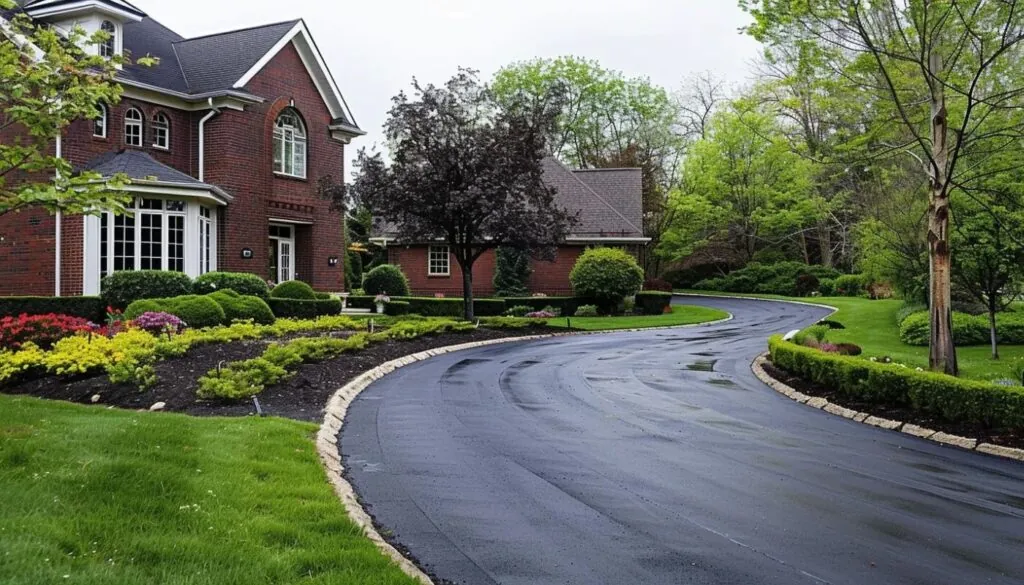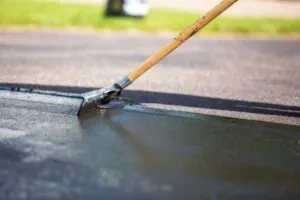Sealing your driveway is a fantastic way to boost your home’s curb appeal and protect your investment. If you are considering a DIY approach, it is essential to avoid common mistakes that can undermine your efforts. DIY driveway sealing might seem straightforward, but without proper knowledge and preparation, it can quickly turn into a frustrating experience.
In this guide, we will discuss the typical pitfalls homeowners face when sealing their driveways independently. From improper surface prep to choosing the wrong sealant, we will cover what to avoid to ensure your project succeeds. By understanding these common errors and how to prevent them, you will be better equipped to achieve a professional-looking finish that stands the test of time.
Let’s dive in and ensure your DIY driveway sealing project goes off without a hitch!
Common Pitfalls in DIY Driveway Sealing
When taking on a DIY driveway sealing project, avoiding common mistakes is crucial to achieving a durable and visually appealing result. Understanding these pitfalls and how to correctly prep the driveway for sealing can save you time, effort, and money. Let’s explore some of the most common mistakes and how to avoid them to ensure your DIY project succeeds. For more detailed insights, consider visiting pros and cons DIY vs professional blacktop driveway sealing.
Overapplying the Sealant
One of the most common mistakes in DIY driveway sealing is overapplying the sealant. It might seem like more is better, but applying too much sealant can lead to problems such as peeling or bubbling. The key is to follow the manufacturer’s instructions regarding the amount needed for your surface. Proper asphalt seal coating requires a balanced application to create a protective layer without excess. To avoid this issue, use the recommended amount and apply it evenly.
Choosing Inadequate Tools
Choosing the right tools is essential for successful DIY driveway sealing. Using inadequate tools can result in uneven application and poor results. For example, applying sealant with a brush or roller not designed for the job can lead to streaks or missed spots. Invest in high-quality, appropriate tools such as a squeegee or a paint roller with a thick nap specifically designed for seal coating a driveway. Using the incorrect tools is a surefire way to sabotage your own seal coating project.
Misusing Sealant for Cracks
Properly addressing cracks is crucial in any driveway sealing project. Many homeowners make the mistake of misusing sealant when dealing with cracks. The sealant for cracks differs from the general seal coat used for the surface. Applying regular sealant to cracks can lead to inadequate filling and a shorter lifespan. To effectively fix cracks, use a crack filler specifically designed for the job and ensure that the cracks are cleaned and prepped before application. This step is essential for a long-lasting repair and a uniform finish.
Insufficient Surface Cleaning
Before starting any DIY driveway sealing project, thorough surface cleaning is vital. Insufficient cleaning can result in poor adhesion and an uneven finish. Dirt leaves, and other debris can prevent the sealant from adequately bonding with the asphalt. To properly prep the driveway for sealing, sweep or pressure wash the surface and remove any stains or oil spots. A clean surface ensures the sealant adheres as intended and provides the appearance you are looking for.
Rushing the Drying Process
Patience is crucial when it comes to drying times after applying sealant. Rushing the drying process can lead to issues such as incomplete curing, leading to a subpar finish. According to the manufacturer’s recommendations, avoid driving on the freshly sealed driveway or exposing it to water until it has fully dried. Rushing the process can damage the seal and also compromise the concrete or asphalt underneath.

Common Pitfalls in DIY
While DIY driveway sealing can save money and provide a sense of accomplishment, it’s easy to make mistakes that can compromise your results. Understanding these common pitfalls will help you avoid them, ensuring your driveway remains protected and visually appealing. There are many ways for homeowners to make a mistake when trying to do a driveway sealing on their own. It can help to be familiar with some of the typical errors, such as overapplying sealant, and insufficient surface cleaning, among many others. Following these tips can help you avoid these issues.
Overapplying the Sealant
One of the most common mistakes in DIY driveway sealing is overapplying the sealant. While it might seem like using more sealant will provide better protection, it can lead to a messier, uneven finish. Too much sealant can result in puddling and take longer to dry, increasing the risk of debris sticking to the surface. When sealing a driveway, applying thin, even layers is crucial. Start by pouring a small amount of sealant and spreading it with a squeegee, ensuring you cover every part of the driveway without excess.
Choosing Inadequate Tools
Another common pitfall is using inadequate tools for the job. The right tools are essential for a successful DIY driveway sealing project. Poor-quality brushes, rollers, or squeegees can lead to uneven application and an unsatisfactory finish. Investing in high-quality tools designed specifically for asphalt seal coating is a wise decision. Good tools help spread the sealant evenly and efficiently, saving time and effort. When selecting tools, ensure they are suitable for the size and type of your driveway. Proper equipment significantly affects the overall quality and durability of the seal coating.
Misusing Sealant for Cracks
Misusing sealant to fill cracks is a frequent mistake among DIYers. Sealant is not designed to fill large cracks or holes; it provides a protective layer over the driveway surface. Using sealant to fill cracks can lead to ineffective sealing and a bumpy surface. Instead, use a crack filler designed for asphalt surfaces before applying the sealant. Correctly filling cracks ensures the sealant adheres better and provides a smooth, even finish. Knowing how to prep the driveway for sealing by addressing cracks first is crucial for achieving the best results.
Insufficient Surface Cleaning
Insufficient surface cleaning is a significant reason why DIY driveway sealing projects fail. Dirt, debris, and oil stains can prevent the sealant from adhering correctly, leading to peeling and a patchy finish. Thoroughly cleaning the driveway before applying sealant is vital. Use a power washer to remove dirt and grime, and treat oil stains with a degreaser—a clean surface ensures the sealer will stick and harden properly.
Rushing the Drying Process

Patience is key when sealing a driveway, but many DIY enthusiasts rush the drying process. Allowing insufficient drying time between coats can cause the sealant to remain tacky and not cure properly, leading to a less durable finish and more frequent reapplications. Depending on the weather conditions, it may take several hours to a full day for each coat to dry completely. To ensure the best results, avoid using the driveway until the sealant has fully cured.
Proper Techniques for Sealcoating a Driveway
Proper techniques are essential to achieving a professional finish when sealing a driveway. Adequate preparation, equipment selection, and application methods ensure your driveway looks great and lasts longer.
Know How to Prep Driveway for Sealing
Proper preparation is the foundation of a successful seal coating project. Before you start, ensure your driveway is clean and debris-free. Begin by sweeping the surface to remove loose dirt and leaves. Use a power washer to eliminate grime and any lingering debris for a deeper clean. Address oil stains with a degreaser, as these can prevent the sealant from adhering correctly. Filling any cracks or holes with an asphalt patching compound is also crucial.
Selecting the Right Equipment
Choosing the right equipment is vital for a successful driveway sealing project. Quality tools significantly affect the application process and the final result. To seal coat a driveway, you’ll need a squeegee or brush designed to spread sealant evenly. Avoid using cheap or unsuitable tools, which can lead to uneven application and wasted material. Additionally, having a sturdy mixing tool for stirring the sealant is essential to achieving the correct consistency.
Learn the Proper Sealcoating Process
Understanding the proper seal coating process is crucial for achieving the best results. Start by stirring the sealant thoroughly to ensure an even consistency. Pour a small amount of sealant onto the driveway and spread it evenly with your squeegee or brush, working in small sections. Apply thin, uniform layers rather than one thick coat, allowing each layer to dry completely before applying the next. Be mindful of weather conditions; seal coating should be done on a dry, warm day to ensure proper curing.
Hire Professional Driveway Sealing Services
While DIY driveway sealing can be rewarding, hiring professional services ensures a flawless, long-lasting finish. Professionals have the expertise, high-quality materials, and specialized equipment to handle the job efficiently and effectively. They can accurately assess the condition of your driveway, address any issues, and apply the sealant with precision, saving you time and potential frustration.
Investing in professional services also means peace of mind, as you can trust the job will be done right the first time. This enhances your driveway’s appearance and extends its lifespan, protecting your investment. For the best results, consider hiring experts who can deliver a durable and aesthetically pleasing finish. For more insights, checking out why you should sealcoat your driveway could provide valuable information.
Conclusion
Sealing your driveway yourself can be a cost-effective and satisfying project, but avoiding common mistakes is crucial to achieving a professional finish. Attention to detail is vital, from proper surface preparation to using the right tools and techniques. However, hiring professional driveway sealing services is a wise investment if you want to ensure the best possible results with minimal hassle. Whether you choose to DIY or go with the pros, understanding the process will help you keep your driveway looking great and protected for years, long after applying the sealer.



